Professional Development Plan
VerifiedAdded on 2022/12/19
|19
|3981
|99
AI Summary
This document discusses the importance of emotional intelligence and critical thinking behavior, the authenticity of communication of a financial advisor, evaluation of heuristics, decisions, and biases. It also includes quizzes on investment decisions and biases.
Contribute Materials
Your contribution can guide someone’s learning journey. Share your
documents today.

Professional Development Plan
Secure Best Marks with AI Grader
Need help grading? Try our AI Grader for instant feedback on your assignments.

Table of Contents
Introduction......................................................................................................................................3
Comparison of emotional intelligence and critical thinking behavior.............................................4
A critical examination of the authenticity of communication of a financial advisor......................6
Evaluation of range of heuristics, decisions and biases...................................................................8
Professional development plan......................................................................................................14
Conclusion.....................................................................................................................................15
Summary........................................................................................................................................16
References......................................................................................................................................17
Page 2 of 19
Introduction......................................................................................................................................3
Comparison of emotional intelligence and critical thinking behavior.............................................4
A critical examination of the authenticity of communication of a financial advisor......................6
Evaluation of range of heuristics, decisions and biases...................................................................8
Professional development plan......................................................................................................14
Conclusion.....................................................................................................................................15
Summary........................................................................................................................................16
References......................................................................................................................................17
Page 2 of 19

Introduction
A professional development plan or PDP is also known as the employee development plan that
helps to identify the career goals of an individual that set out a strategy for achieving all the
necessary objectives. Behavioral finance is one of the essential elements that create an effective
approach for initiating a successful professional development plan that can help an individual to
meet with all the specific objectives of achieving all the potential market success factors (Rubens
et al. 2018). Emotional intelligence highlights the cognitive and rational intelligence factors that
examine the emotional intelligence of an individual. Furthermore, the financial planner of the
organization needs to emphasize the basic importance of emotions that provide a piece of
effective financial advice. In addition to that, effective communication channels must be
identified that can reduce the gaps between competent and incompetent financial performances
(Choy and Chua, 2019). Identifying the consumer behavior of the targeted customer base can
provide additional help in making decisions that can lead to a successful investment decision.
The following report will compare the emotional and intelligence behaviors along with which the
authenticity of the financial advisors will be examined. Moreover, an evaluation of the range of
heuristics, decisions, and biases will be given. In addition to that, a professional development
plan will be given (Lewis et al. 2016).
Page 3 of 19
A professional development plan or PDP is also known as the employee development plan that
helps to identify the career goals of an individual that set out a strategy for achieving all the
necessary objectives. Behavioral finance is one of the essential elements that create an effective
approach for initiating a successful professional development plan that can help an individual to
meet with all the specific objectives of achieving all the potential market success factors (Rubens
et al. 2018). Emotional intelligence highlights the cognitive and rational intelligence factors that
examine the emotional intelligence of an individual. Furthermore, the financial planner of the
organization needs to emphasize the basic importance of emotions that provide a piece of
effective financial advice. In addition to that, effective communication channels must be
identified that can reduce the gaps between competent and incompetent financial performances
(Choy and Chua, 2019). Identifying the consumer behavior of the targeted customer base can
provide additional help in making decisions that can lead to a successful investment decision.
The following report will compare the emotional and intelligence behaviors along with which the
authenticity of the financial advisors will be examined. Moreover, an evaluation of the range of
heuristics, decisions, and biases will be given. In addition to that, a professional development
plan will be given (Lewis et al. 2016).
Page 3 of 19
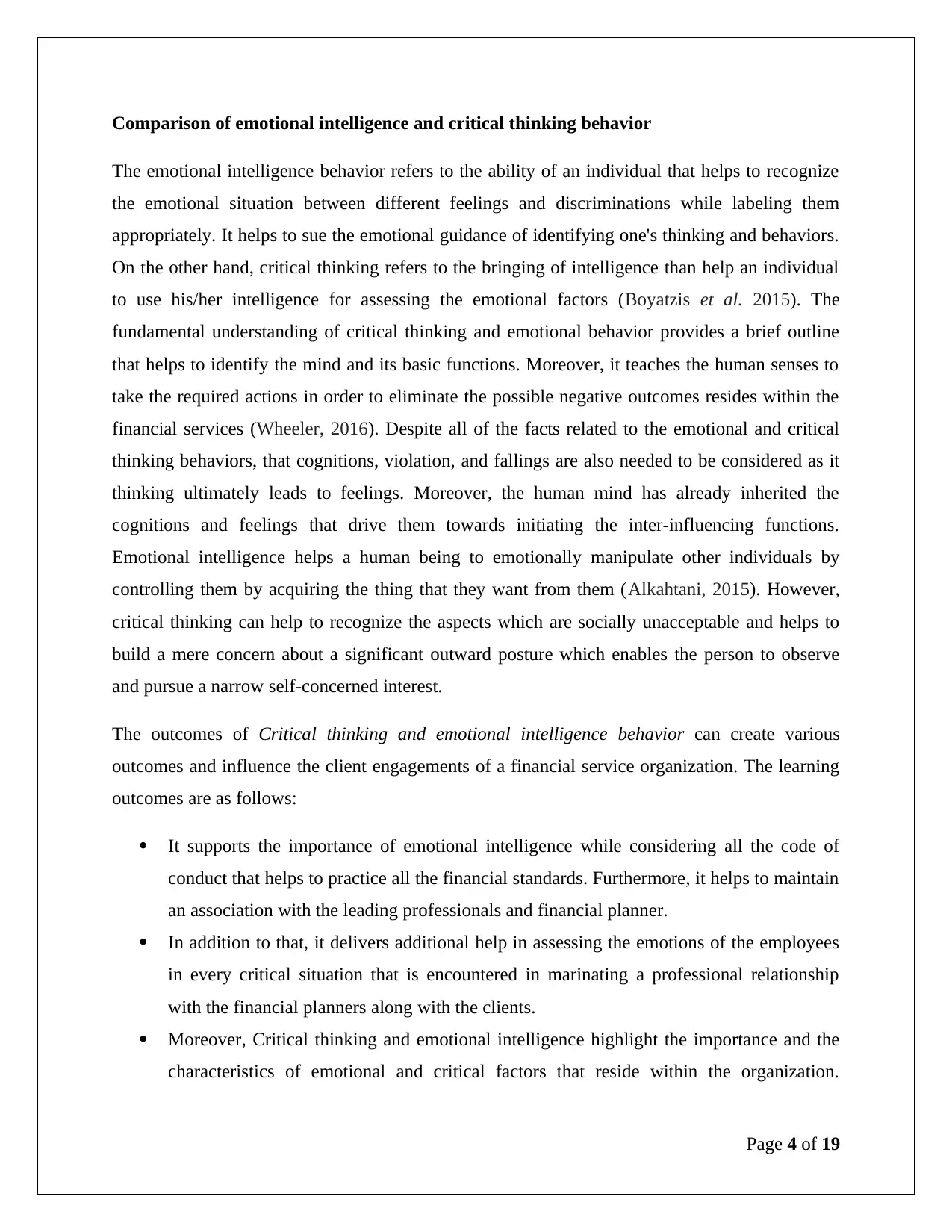
Comparison of emotional intelligence and critical thinking behavior
The emotional intelligence behavior refers to the ability of an individual that helps to recognize
the emotional situation between different feelings and discriminations while labeling them
appropriately. It helps to sue the emotional guidance of identifying one's thinking and behaviors.
On the other hand, critical thinking refers to the bringing of intelligence than help an individual
to use his/her intelligence for assessing the emotional factors (Boyatzis et al. 2015). The
fundamental understanding of critical thinking and emotional behavior provides a brief outline
that helps to identify the mind and its basic functions. Moreover, it teaches the human senses to
take the required actions in order to eliminate the possible negative outcomes resides within the
financial services (Wheeler, 2016). Despite all of the facts related to the emotional and critical
thinking behaviors, that cognitions, violation, and fallings are also needed to be considered as it
thinking ultimately leads to feelings. Moreover, the human mind has already inherited the
cognitions and feelings that drive them towards initiating the inter-influencing functions.
Emotional intelligence helps a human being to emotionally manipulate other individuals by
controlling them by acquiring the thing that they want from them (Alkahtani, 2015). However,
critical thinking can help to recognize the aspects which are socially unacceptable and helps to
build a mere concern about a significant outward posture which enables the person to observe
and pursue a narrow self-concerned interest.
The outcomes of Critical thinking and emotional intelligence behavior can create various
outcomes and influence the client engagements of a financial service organization. The learning
outcomes are as follows:
It supports the importance of emotional intelligence while considering all the code of
conduct that helps to practice all the financial standards. Furthermore, it helps to maintain
an association with the leading professionals and financial planner.
In addition to that, it delivers additional help in assessing the emotions of the employees
in every critical situation that is encountered in marinating a professional relationship
with the financial planners along with the clients.
Moreover, Critical thinking and emotional intelligence highlight the importance and the
characteristics of emotional and critical factors that reside within the organization.
Page 4 of 19
The emotional intelligence behavior refers to the ability of an individual that helps to recognize
the emotional situation between different feelings and discriminations while labeling them
appropriately. It helps to sue the emotional guidance of identifying one's thinking and behaviors.
On the other hand, critical thinking refers to the bringing of intelligence than help an individual
to use his/her intelligence for assessing the emotional factors (Boyatzis et al. 2015). The
fundamental understanding of critical thinking and emotional behavior provides a brief outline
that helps to identify the mind and its basic functions. Moreover, it teaches the human senses to
take the required actions in order to eliminate the possible negative outcomes resides within the
financial services (Wheeler, 2016). Despite all of the facts related to the emotional and critical
thinking behaviors, that cognitions, violation, and fallings are also needed to be considered as it
thinking ultimately leads to feelings. Moreover, the human mind has already inherited the
cognitions and feelings that drive them towards initiating the inter-influencing functions.
Emotional intelligence helps a human being to emotionally manipulate other individuals by
controlling them by acquiring the thing that they want from them (Alkahtani, 2015). However,
critical thinking can help to recognize the aspects which are socially unacceptable and helps to
build a mere concern about a significant outward posture which enables the person to observe
and pursue a narrow self-concerned interest.
The outcomes of Critical thinking and emotional intelligence behavior can create various
outcomes and influence the client engagements of a financial service organization. The learning
outcomes are as follows:
It supports the importance of emotional intelligence while considering all the code of
conduct that helps to practice all the financial standards. Furthermore, it helps to maintain
an association with the leading professionals and financial planner.
In addition to that, it delivers additional help in assessing the emotions of the employees
in every critical situation that is encountered in marinating a professional relationship
with the financial planners along with the clients.
Moreover, Critical thinking and emotional intelligence highlight the importance and the
characteristics of emotional and critical factors that reside within the organization.
Page 4 of 19
Secure Best Marks with AI Grader
Need help grading? Try our AI Grader for instant feedback on your assignments.
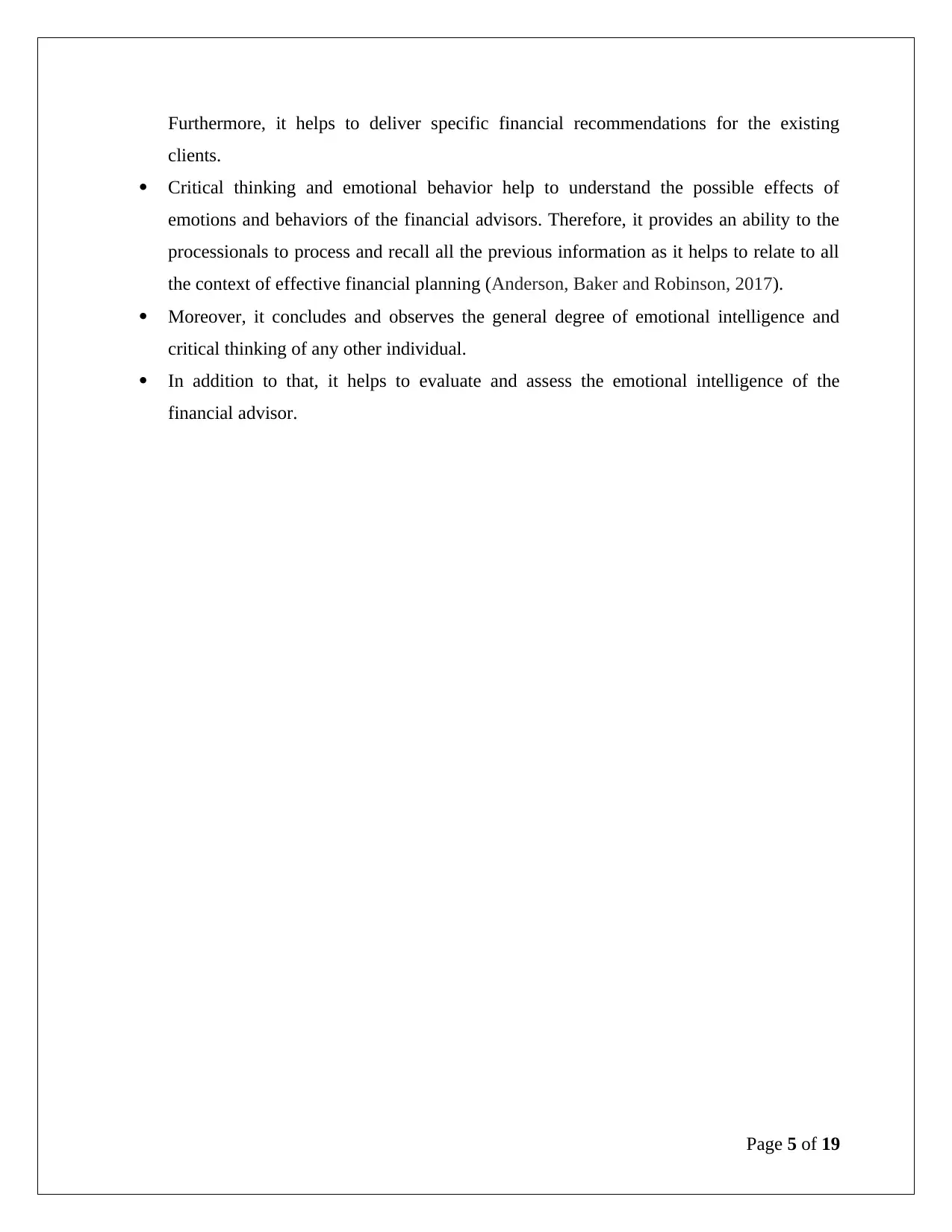
Furthermore, it helps to deliver specific financial recommendations for the existing
clients.
Critical thinking and emotional behavior help to understand the possible effects of
emotions and behaviors of the financial advisors. Therefore, it provides an ability to the
processionals to process and recall all the previous information as it helps to relate to all
the context of effective financial planning (Anderson, Baker and Robinson, 2017).
Moreover, it concludes and observes the general degree of emotional intelligence and
critical thinking of any other individual.
In addition to that, it helps to evaluate and assess the emotional intelligence of the
financial advisor.
Page 5 of 19
clients.
Critical thinking and emotional behavior help to understand the possible effects of
emotions and behaviors of the financial advisors. Therefore, it provides an ability to the
processionals to process and recall all the previous information as it helps to relate to all
the context of effective financial planning (Anderson, Baker and Robinson, 2017).
Moreover, it concludes and observes the general degree of emotional intelligence and
critical thinking of any other individual.
In addition to that, it helps to evaluate and assess the emotional intelligence of the
financial advisor.
Page 5 of 19

A critical examination of the authenticity of communication of a financial advisor
The communication style of an individual can be an extension that highlights the personality of
the person. Moreover, communication is considered as an essential output of a person's
emotional intelligence and self-awareness. However, in order to initiate authentic communication
the individual needs to be true and legit towards his/her values. In addition to that, the personal
values can be projected through a financial planner that can select the pattern of the financial
planner (West et al. 2017).
There are three basic modes, such as verbal and non-verbal communications, which reflect the
body posture, eye movement, stance of an individual while he/she is engaging with a
communicative segment with another person. Considering these factors ensures the authenticity
of the communication. However, authenticity is an abstract perception that is not much of
observable behavior as it can bring harm to the credibility along with the trust factors, placed
within the financial partners and clients. Therefore, the results of an in-authentic communication
include a negative response from the clients and create a barrier in implementing a piece of
financial advice in order to engage in effective financial planning. Moreover, the communicating
style refers to a specific extension that reflects the personality of a person (Austin, and Pinkleton,
2015). In addition to that, authentic communication delivers a personal value that is projected by
the financial planner that solidifies the relations between the customer and the organization. In
addition to that, the key skill of a financial planner is the curiosity that helps them to identify the
advisory requirements of the client. Furthermore, identifying and understanding the basic
financial requirements of the client that helps to develop a good relationship.
Moreover, a client most likely avoids the financial advice that is being provided to him/her by
the company, because the advisor mostly avoids the value proposition factor of the client.
However, through considering the three basic communication modes, the Non-verbal
communication mainly interacts with the process through which the communication process is
being interpreted (Kan, and Zhang, 2017). Therefore, the company's financial planner who might
miss-interpreted the client's motivations and will fail to deliver the necessary financial advice
mostly encounters the resistance from the client for accepting their financial advice. Therefore, it
is vital to identify the client's credibility and acceptance of a message. Moreover, credible
Page 6 of 19
The communication style of an individual can be an extension that highlights the personality of
the person. Moreover, communication is considered as an essential output of a person's
emotional intelligence and self-awareness. However, in order to initiate authentic communication
the individual needs to be true and legit towards his/her values. In addition to that, the personal
values can be projected through a financial planner that can select the pattern of the financial
planner (West et al. 2017).
There are three basic modes, such as verbal and non-verbal communications, which reflect the
body posture, eye movement, stance of an individual while he/she is engaging with a
communicative segment with another person. Considering these factors ensures the authenticity
of the communication. However, authenticity is an abstract perception that is not much of
observable behavior as it can bring harm to the credibility along with the trust factors, placed
within the financial partners and clients. Therefore, the results of an in-authentic communication
include a negative response from the clients and create a barrier in implementing a piece of
financial advice in order to engage in effective financial planning. Moreover, the communicating
style refers to a specific extension that reflects the personality of a person (Austin, and Pinkleton,
2015). In addition to that, authentic communication delivers a personal value that is projected by
the financial planner that solidifies the relations between the customer and the organization. In
addition to that, the key skill of a financial planner is the curiosity that helps them to identify the
advisory requirements of the client. Furthermore, identifying and understanding the basic
financial requirements of the client that helps to develop a good relationship.
Moreover, a client most likely avoids the financial advice that is being provided to him/her by
the company, because the advisor mostly avoids the value proposition factor of the client.
However, through considering the three basic communication modes, the Non-verbal
communication mainly interacts with the process through which the communication process is
being interpreted (Kan, and Zhang, 2017). Therefore, the company's financial planner who might
miss-interpreted the client's motivations and will fail to deliver the necessary financial advice
mostly encounters the resistance from the client for accepting their financial advice. Therefore, it
is vital to identify the client's credibility and acceptance of a message. Moreover, credible
Page 6 of 19
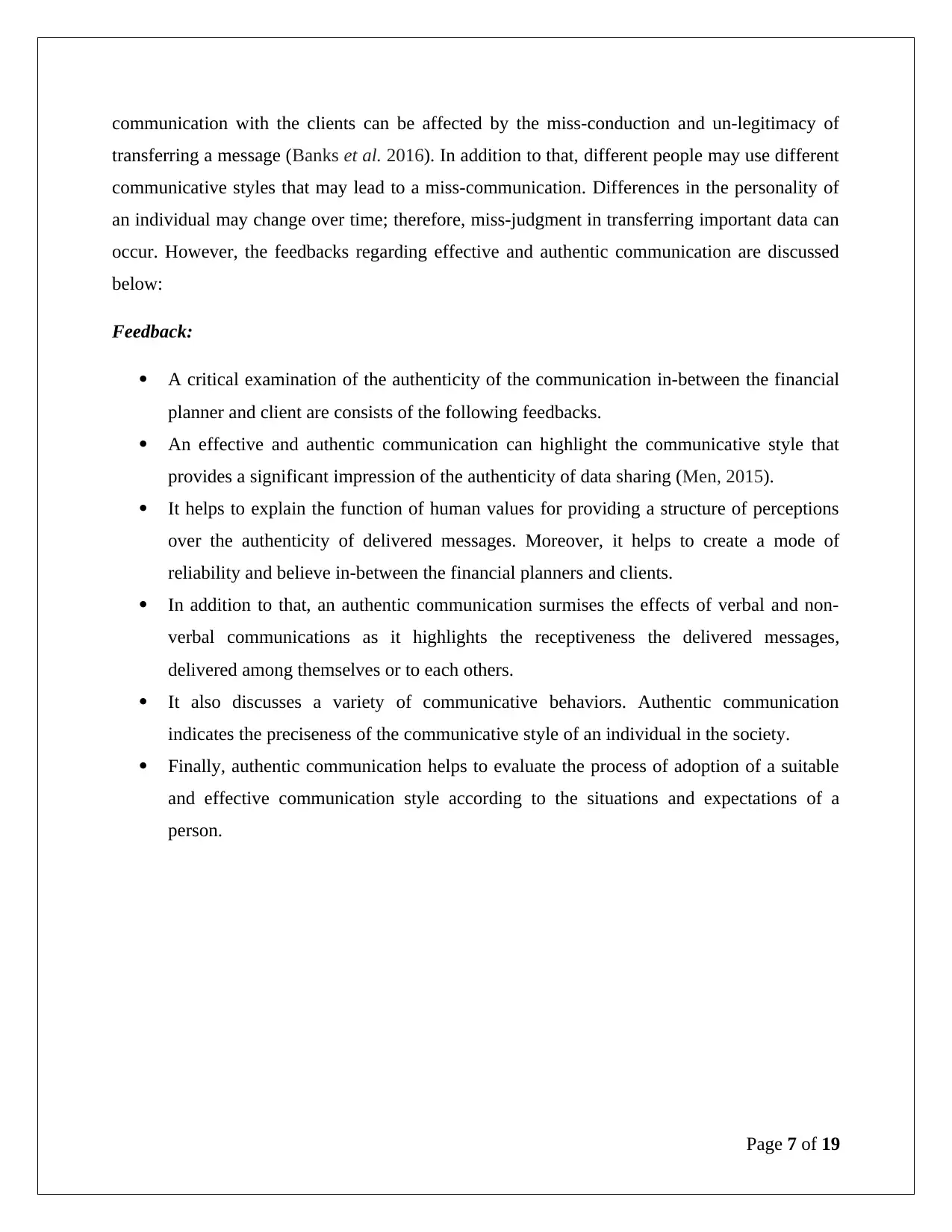
communication with the clients can be affected by the miss-conduction and un-legitimacy of
transferring a message (Banks et al. 2016). In addition to that, different people may use different
communicative styles that may lead to a miss-communication. Differences in the personality of
an individual may change over time; therefore, miss-judgment in transferring important data can
occur. However, the feedbacks regarding effective and authentic communication are discussed
below:
Feedback:
A critical examination of the authenticity of the communication in-between the financial
planner and client are consists of the following feedbacks.
An effective and authentic communication can highlight the communicative style that
provides a significant impression of the authenticity of data sharing (Men, 2015).
It helps to explain the function of human values for providing a structure of perceptions
over the authenticity of delivered messages. Moreover, it helps to create a mode of
reliability and believe in-between the financial planners and clients.
In addition to that, an authentic communication surmises the effects of verbal and non-
verbal communications as it highlights the receptiveness the delivered messages,
delivered among themselves or to each others.
It also discusses a variety of communicative behaviors. Authentic communication
indicates the preciseness of the communicative style of an individual in the society.
Finally, authentic communication helps to evaluate the process of adoption of a suitable
and effective communication style according to the situations and expectations of a
person.
Page 7 of 19
transferring a message (Banks et al. 2016). In addition to that, different people may use different
communicative styles that may lead to a miss-communication. Differences in the personality of
an individual may change over time; therefore, miss-judgment in transferring important data can
occur. However, the feedbacks regarding effective and authentic communication are discussed
below:
Feedback:
A critical examination of the authenticity of the communication in-between the financial
planner and client are consists of the following feedbacks.
An effective and authentic communication can highlight the communicative style that
provides a significant impression of the authenticity of data sharing (Men, 2015).
It helps to explain the function of human values for providing a structure of perceptions
over the authenticity of delivered messages. Moreover, it helps to create a mode of
reliability and believe in-between the financial planners and clients.
In addition to that, an authentic communication surmises the effects of verbal and non-
verbal communications as it highlights the receptiveness the delivered messages,
delivered among themselves or to each others.
It also discusses a variety of communicative behaviors. Authentic communication
indicates the preciseness of the communicative style of an individual in the society.
Finally, authentic communication helps to evaluate the process of adoption of a suitable
and effective communication style according to the situations and expectations of a
person.
Page 7 of 19
Paraphrase This Document
Need a fresh take? Get an instant paraphrase of this document with our AI Paraphraser
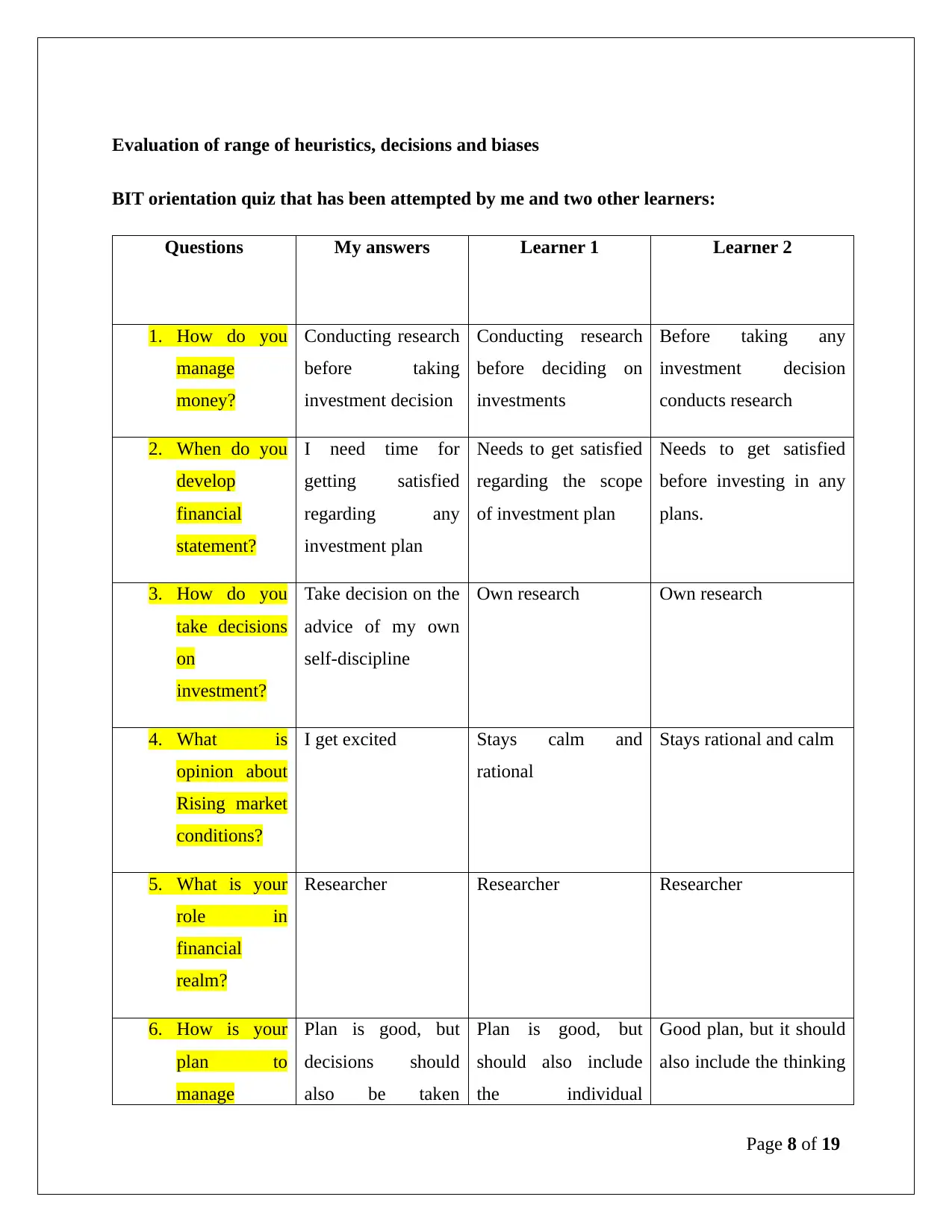
Evaluation of range of heuristics, decisions and biases
BIT orientation quiz that has been attempted by me and two other learners:
Questions My answers Learner 1 Learner 2
1. How do you
manage
money?
Conducting research
before taking
investment decision
Conducting research
before deciding on
investments
Before taking any
investment decision
conducts research
2. When do you
develop
financial
statement?
I need time for
getting satisfied
regarding any
investment plan
Needs to get satisfied
regarding the scope
of investment plan
Needs to get satisfied
before investing in any
plans.
3. How do you
take decisions
on
investment?
Take decision on the
advice of my own
self-discipline
Own research Own research
4. What is
opinion about
Rising market
conditions?
I get excited Stays calm and
rational
Stays rational and calm
5. What is your
role in
financial
realm?
Researcher Researcher Researcher
6. How is your
plan to
manage
Plan is good, but
decisions should
also be taken
Plan is good, but
should also include
the individual
Good plan, but it should
also include the thinking
Page 8 of 19
BIT orientation quiz that has been attempted by me and two other learners:
Questions My answers Learner 1 Learner 2
1. How do you
manage
money?
Conducting research
before taking
investment decision
Conducting research
before deciding on
investments
Before taking any
investment decision
conducts research
2. When do you
develop
financial
statement?
I need time for
getting satisfied
regarding any
investment plan
Needs to get satisfied
regarding the scope
of investment plan
Needs to get satisfied
before investing in any
plans.
3. How do you
take decisions
on
investment?
Take decision on the
advice of my own
self-discipline
Own research Own research
4. What is
opinion about
Rising market
conditions?
I get excited Stays calm and
rational
Stays rational and calm
5. What is your
role in
financial
realm?
Researcher Researcher Researcher
6. How is your
plan to
manage
Plan is good, but
decisions should
also be taken
Plan is good, but
should also include
the individual
Good plan, but it should
also include the thinking
Page 8 of 19
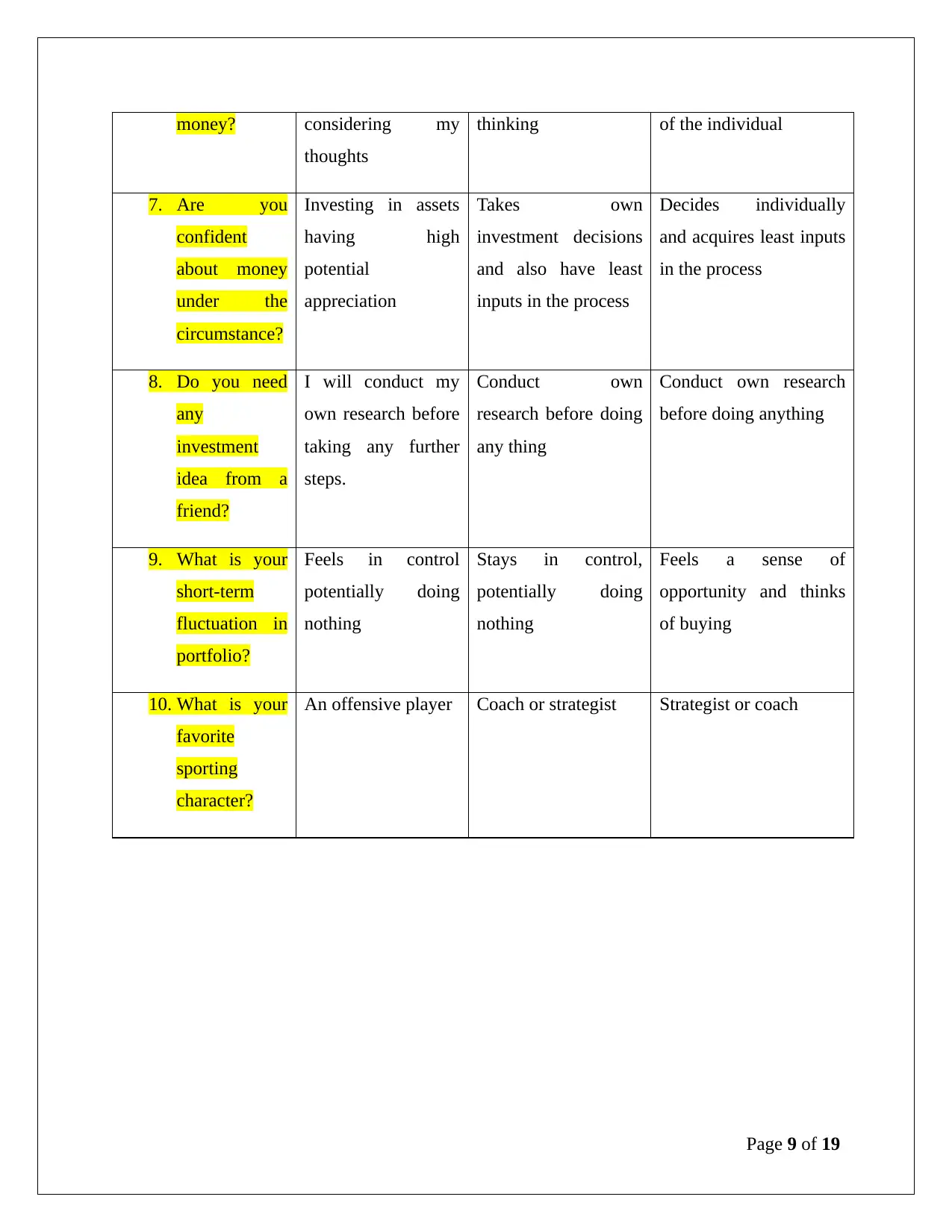
money? considering my
thoughts
thinking of the individual
7. Are you
confident
about money
under the
circumstance?
Investing in assets
having high
potential
appreciation
Takes own
investment decisions
and also have least
inputs in the process
Decides individually
and acquires least inputs
in the process
8. Do you need
any
investment
idea from a
friend?
I will conduct my
own research before
taking any further
steps.
Conduct own
research before doing
any thing
Conduct own research
before doing anything
9. What is your
short-term
fluctuation in
portfolio?
Feels in control
potentially doing
nothing
Stays in control,
potentially doing
nothing
Feels a sense of
opportunity and thinks
of buying
10. What is your
favorite
sporting
character?
An offensive player Coach or strategist Strategist or coach
Page 9 of 19
thoughts
thinking of the individual
7. Are you
confident
about money
under the
circumstance?
Investing in assets
having high
potential
appreciation
Takes own
investment decisions
and also have least
inputs in the process
Decides individually
and acquires least inputs
in the process
8. Do you need
any
investment
idea from a
friend?
I will conduct my
own research before
taking any further
steps.
Conduct own
research before doing
any thing
Conduct own research
before doing anything
9. What is your
short-term
fluctuation in
portfolio?
Feels in control
potentially doing
nothing
Stays in control,
potentially doing
nothing
Feels a sense of
opportunity and thinks
of buying
10. What is your
favorite
sporting
character?
An offensive player Coach or strategist Strategist or coach
Page 9 of 19
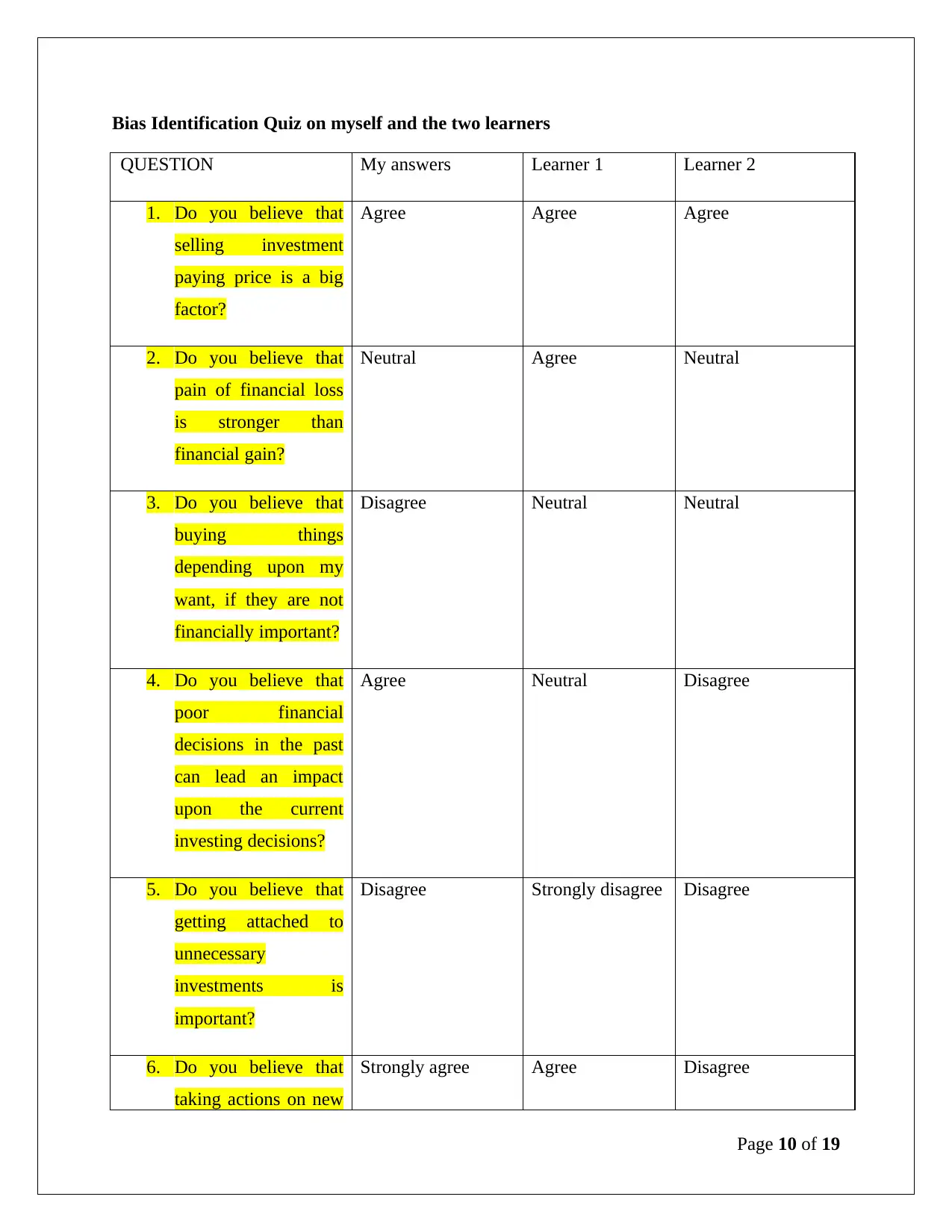
Bias Identification Quiz on myself and the two learners
QUESTION My answers Learner 1 Learner 2
1. Do you believe that
selling investment
paying price is a big
factor?
Agree Agree Agree
2. Do you believe that
pain of financial loss
is stronger than
financial gain?
Neutral Agree Neutral
3. Do you believe that
buying things
depending upon my
want, if they are not
financially important?
Disagree Neutral Neutral
4. Do you believe that
poor financial
decisions in the past
can lead an impact
upon the current
investing decisions?
Agree Neutral Disagree
5. Do you believe that
getting attached to
unnecessary
investments is
important?
Disagree Strongly disagree Disagree
6. Do you believe that
taking actions on new
Strongly agree Agree Disagree
Page 10 of 19
QUESTION My answers Learner 1 Learner 2
1. Do you believe that
selling investment
paying price is a big
factor?
Agree Agree Agree
2. Do you believe that
pain of financial loss
is stronger than
financial gain?
Neutral Agree Neutral
3. Do you believe that
buying things
depending upon my
want, if they are not
financially important?
Disagree Neutral Neutral
4. Do you believe that
poor financial
decisions in the past
can lead an impact
upon the current
investing decisions?
Agree Neutral Disagree
5. Do you believe that
getting attached to
unnecessary
investments is
important?
Disagree Strongly disagree Disagree
6. Do you believe that
taking actions on new
Strongly agree Agree Disagree
Page 10 of 19
Secure Best Marks with AI Grader
Need help grading? Try our AI Grader for instant feedback on your assignments.
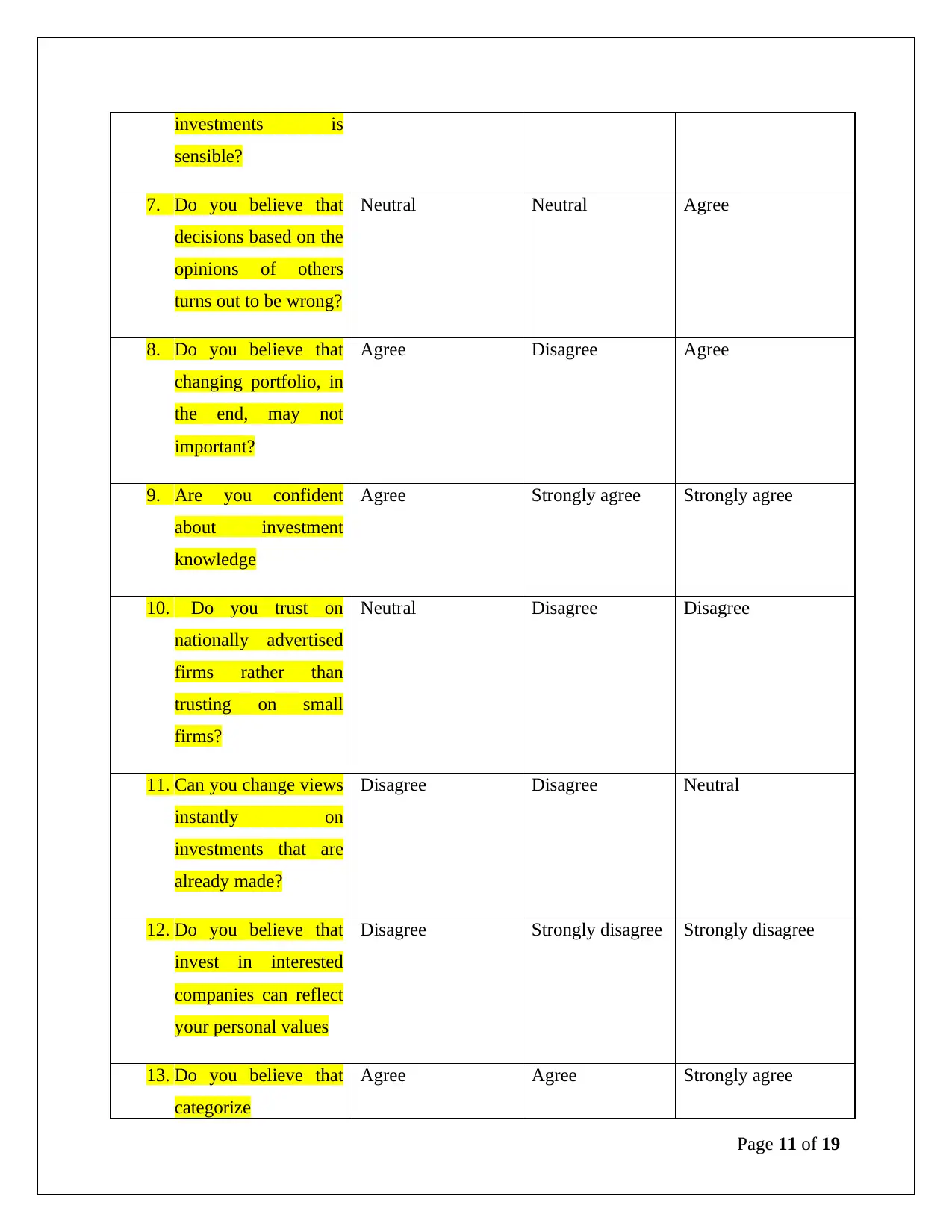
investments is
sensible?
7. Do you believe that
decisions based on the
opinions of others
turns out to be wrong?
Neutral Neutral Agree
8. Do you believe that
changing portfolio, in
the end, may not
important?
Agree Disagree Agree
9. Are you confident
about investment
knowledge
Agree Strongly agree Strongly agree
10. Do you trust on
nationally advertised
firms rather than
trusting on small
firms?
Neutral Disagree Disagree
11. Can you change views
instantly on
investments that are
already made?
Disagree Disagree Neutral
12. Do you believe that
invest in interested
companies can reflect
your personal values
Disagree Strongly disagree Strongly disagree
13. Do you believe that
categorize
Agree Agree Strongly agree
Page 11 of 19
sensible?
7. Do you believe that
decisions based on the
opinions of others
turns out to be wrong?
Neutral Neutral Agree
8. Do you believe that
changing portfolio, in
the end, may not
important?
Agree Disagree Agree
9. Are you confident
about investment
knowledge
Agree Strongly agree Strongly agree
10. Do you trust on
nationally advertised
firms rather than
trusting on small
firms?
Neutral Disagree Disagree
11. Can you change views
instantly on
investments that are
already made?
Disagree Disagree Neutral
12. Do you believe that
invest in interested
companies can reflect
your personal values
Disagree Strongly disagree Strongly disagree
13. Do you believe that
categorize
Agree Agree Strongly agree
Page 11 of 19
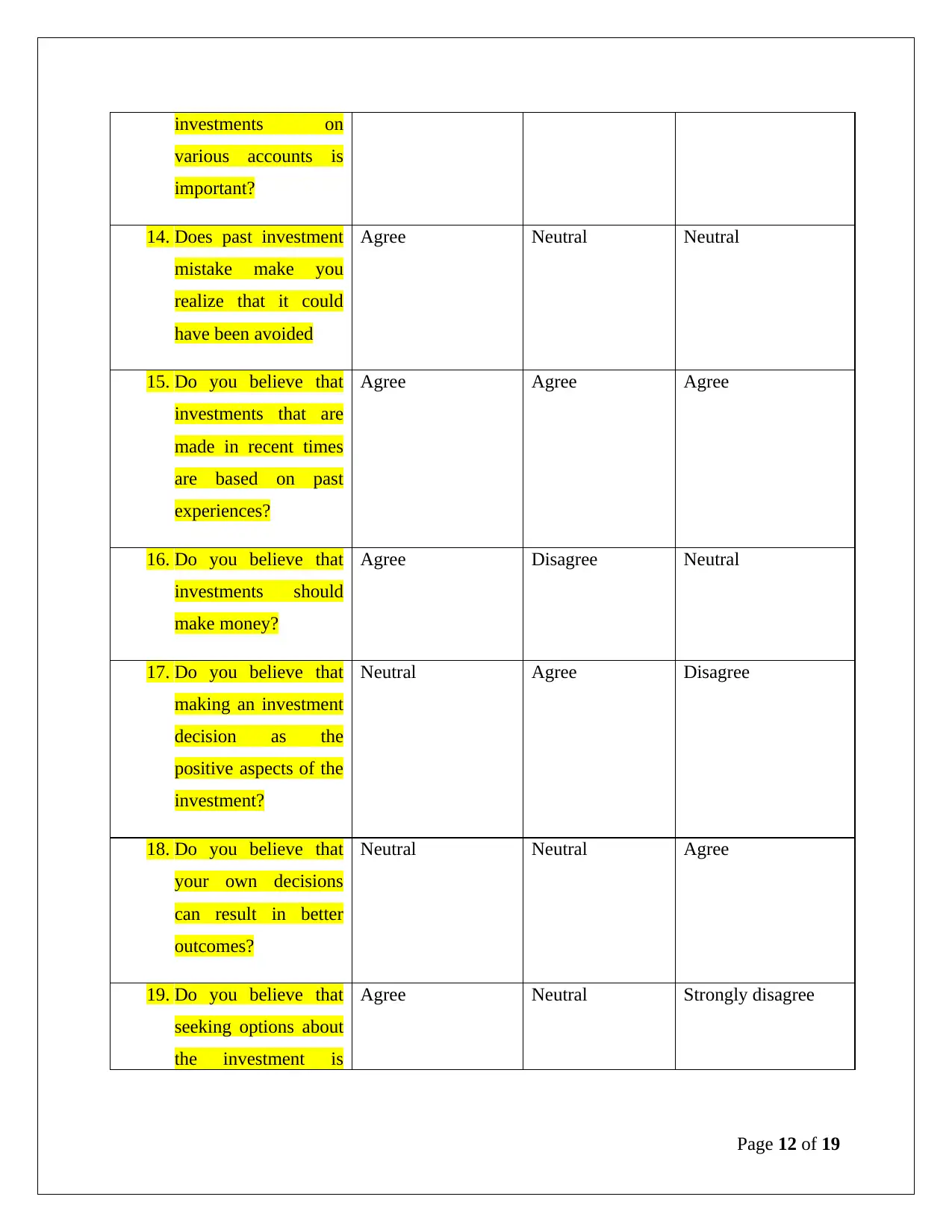
investments on
various accounts is
important?
14. Does past investment
mistake make you
realize that it could
have been avoided
Agree Neutral Neutral
15. Do you believe that
investments that are
made in recent times
are based on past
experiences?
Agree Agree Agree
16. Do you believe that
investments should
make money?
Agree Disagree Neutral
17. Do you believe that
making an investment
decision as the
positive aspects of the
investment?
Neutral Agree Disagree
18. Do you believe that
your own decisions
can result in better
outcomes?
Neutral Neutral Agree
19. Do you believe that
seeking options about
the investment is
Agree Neutral Strongly disagree
Page 12 of 19
various accounts is
important?
14. Does past investment
mistake make you
realize that it could
have been avoided
Agree Neutral Neutral
15. Do you believe that
investments that are
made in recent times
are based on past
experiences?
Agree Agree Agree
16. Do you believe that
investments should
make money?
Agree Disagree Neutral
17. Do you believe that
making an investment
decision as the
positive aspects of the
investment?
Neutral Agree Disagree
18. Do you believe that
your own decisions
can result in better
outcomes?
Neutral Neutral Agree
19. Do you believe that
seeking options about
the investment is
Agree Neutral Strongly disagree
Page 12 of 19

important?
20. Do you believe that
you should put more
focus on recent times
rather than on the past
record?
Disagree Neutral Disagree
Summary of Quizzes
The BIT Orientation Quiz and the Bias Identification quiz are conducted over me and the two
learners evaluate the nature of the individuals while making investing decisions and investing
their money in the future. In the BIT Orientation, my decisions show the tendency of
accumulator orientation. The first learner's orientation shows the tendency of observing an
independent orientation (Hoover, Giambatista and Westney, 2019). The second learner's
orientation in the scope of investing in investment shows the tendency of independent
orientation. The Bias Identification Quiz estimates subtract and observe the value that can be
achieved from an investment. The Bias Identification Quiz which has been answered by me
signifies the importance of my research and data collection and observing the records of the
investments, upon which I have trusted to invest my money (Medora and Roy, 2017). My past
experiences which turned out to be poor in case of investment also help me in taking any future
risk about investment. The scheme and scope of getting returns on investment have been known
to me out of my analysis and after incurring a loss in certain investments. It was also agreed by
all the learners and also by me that the pain of losing returns from any investment is quite higher
than gaining any return from the investment.
Page 13 of 19
20. Do you believe that
you should put more
focus on recent times
rather than on the past
record?
Disagree Neutral Disagree
Summary of Quizzes
The BIT Orientation Quiz and the Bias Identification quiz are conducted over me and the two
learners evaluate the nature of the individuals while making investing decisions and investing
their money in the future. In the BIT Orientation, my decisions show the tendency of
accumulator orientation. The first learner's orientation shows the tendency of observing an
independent orientation (Hoover, Giambatista and Westney, 2019). The second learner's
orientation in the scope of investing in investment shows the tendency of independent
orientation. The Bias Identification Quiz estimates subtract and observe the value that can be
achieved from an investment. The Bias Identification Quiz which has been answered by me
signifies the importance of my research and data collection and observing the records of the
investments, upon which I have trusted to invest my money (Medora and Roy, 2017). My past
experiences which turned out to be poor in case of investment also help me in taking any future
risk about investment. The scheme and scope of getting returns on investment have been known
to me out of my analysis and after incurring a loss in certain investments. It was also agreed by
all the learners and also by me that the pain of losing returns from any investment is quite higher
than gaining any return from the investment.
Page 13 of 19
Paraphrase This Document
Need a fresh take? Get an instant paraphrase of this document with our AI Paraphraser
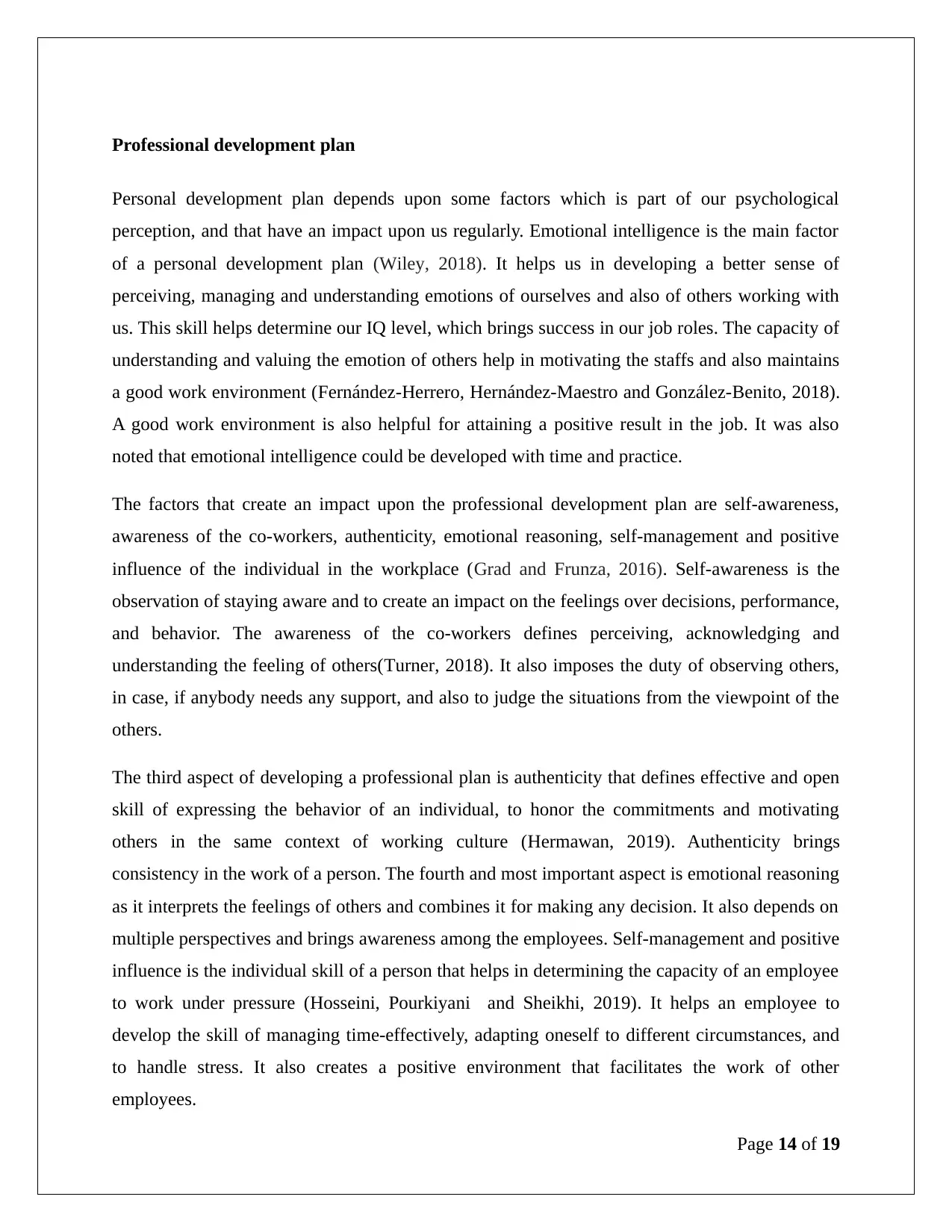
Professional development plan
Personal development plan depends upon some factors which is part of our psychological
perception, and that have an impact upon us regularly. Emotional intelligence is the main factor
of a personal development plan (Wiley, 2018). It helps us in developing a better sense of
perceiving, managing and understanding emotions of ourselves and also of others working with
us. This skill helps determine our IQ level, which brings success in our job roles. The capacity of
understanding and valuing the emotion of others help in motivating the staffs and also maintains
a good work environment (Fernández-Herrero, Hernández-Maestro and González-Benito, 2018).
A good work environment is also helpful for attaining a positive result in the job. It was also
noted that emotional intelligence could be developed with time and practice.
The factors that create an impact upon the professional development plan are self-awareness,
awareness of the co-workers, authenticity, emotional reasoning, self-management and positive
influence of the individual in the workplace (Grad and Frunza, 2016). Self-awareness is the
observation of staying aware and to create an impact on the feelings over decisions, performance,
and behavior. The awareness of the co-workers defines perceiving, acknowledging and
understanding the feeling of others(Turner, 2018). It also imposes the duty of observing others,
in case, if anybody needs any support, and also to judge the situations from the viewpoint of the
others.
The third aspect of developing a professional plan is authenticity that defines effective and open
skill of expressing the behavior of an individual, to honor the commitments and motivating
others in the same context of working culture (Hermawan, 2019). Authenticity brings
consistency in the work of a person. The fourth and most important aspect is emotional reasoning
as it interprets the feelings of others and combines it for making any decision. It also depends on
multiple perspectives and brings awareness among the employees. Self-management and positive
influence is the individual skill of a person that helps in determining the capacity of an employee
to work under pressure (Hosseini, Pourkiyani and Sheikhi, 2019). It helps an employee to
develop the skill of managing time-effectively, adapting oneself to different circumstances, and
to handle stress. It also creates a positive environment that facilitates the work of other
employees.
Page 14 of 19
Personal development plan depends upon some factors which is part of our psychological
perception, and that have an impact upon us regularly. Emotional intelligence is the main factor
of a personal development plan (Wiley, 2018). It helps us in developing a better sense of
perceiving, managing and understanding emotions of ourselves and also of others working with
us. This skill helps determine our IQ level, which brings success in our job roles. The capacity of
understanding and valuing the emotion of others help in motivating the staffs and also maintains
a good work environment (Fernández-Herrero, Hernández-Maestro and González-Benito, 2018).
A good work environment is also helpful for attaining a positive result in the job. It was also
noted that emotional intelligence could be developed with time and practice.
The factors that create an impact upon the professional development plan are self-awareness,
awareness of the co-workers, authenticity, emotional reasoning, self-management and positive
influence of the individual in the workplace (Grad and Frunza, 2016). Self-awareness is the
observation of staying aware and to create an impact on the feelings over decisions, performance,
and behavior. The awareness of the co-workers defines perceiving, acknowledging and
understanding the feeling of others(Turner, 2018). It also imposes the duty of observing others,
in case, if anybody needs any support, and also to judge the situations from the viewpoint of the
others.
The third aspect of developing a professional plan is authenticity that defines effective and open
skill of expressing the behavior of an individual, to honor the commitments and motivating
others in the same context of working culture (Hermawan, 2019). Authenticity brings
consistency in the work of a person. The fourth and most important aspect is emotional reasoning
as it interprets the feelings of others and combines it for making any decision. It also depends on
multiple perspectives and brings awareness among the employees. Self-management and positive
influence is the individual skill of a person that helps in determining the capacity of an employee
to work under pressure (Hosseini, Pourkiyani and Sheikhi, 2019). It helps an employee to
develop the skill of managing time-effectively, adapting oneself to different circumstances, and
to handle stress. It also creates a positive environment that facilitates the work of other
employees.
Page 14 of 19
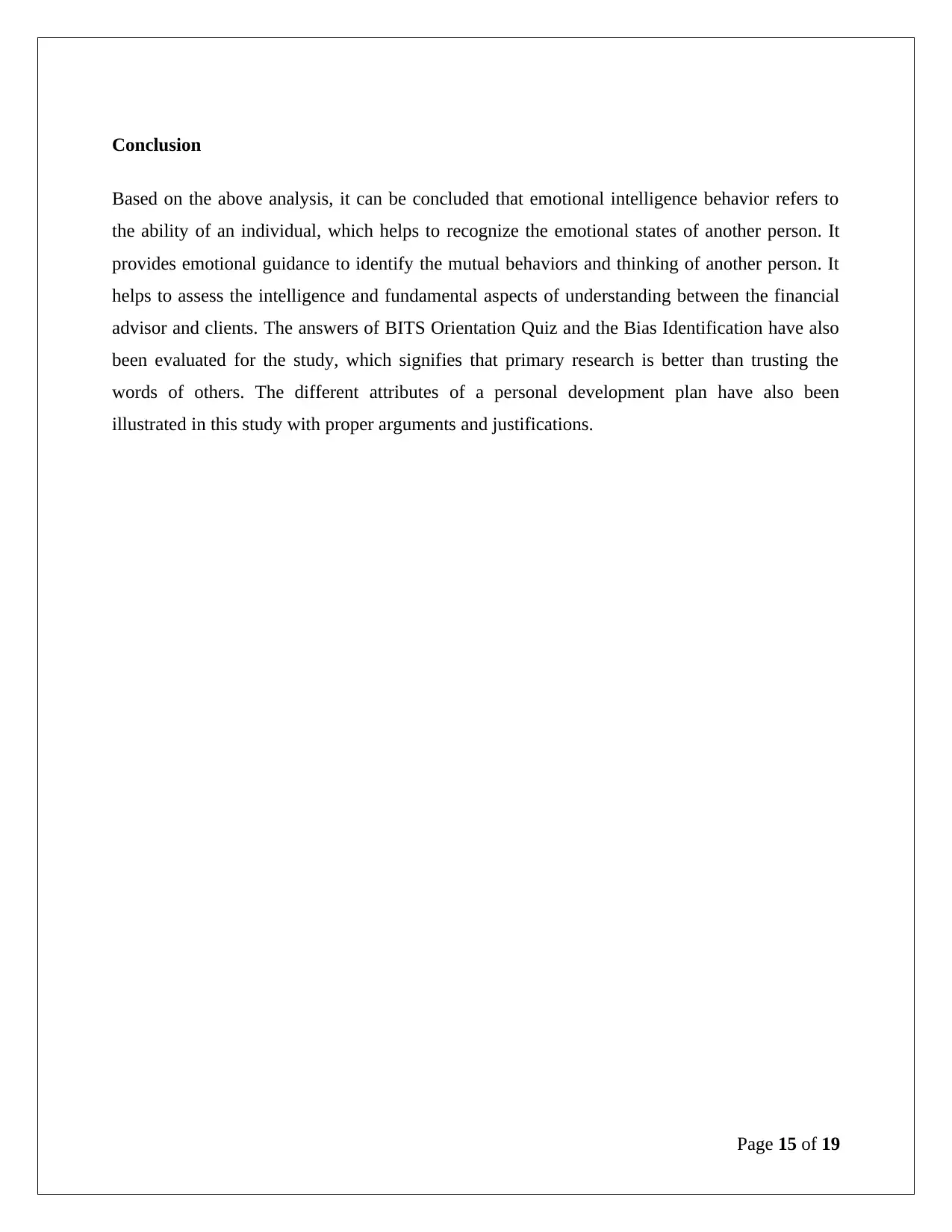
Conclusion
Based on the above analysis, it can be concluded that emotional intelligence behavior refers to
the ability of an individual, which helps to recognize the emotional states of another person. It
provides emotional guidance to identify the mutual behaviors and thinking of another person. It
helps to assess the intelligence and fundamental aspects of understanding between the financial
advisor and clients. The answers of BITS Orientation Quiz and the Bias Identification have also
been evaluated for the study, which signifies that primary research is better than trusting the
words of others. The different attributes of a personal development plan have also been
illustrated in this study with proper arguments and justifications.
Page 15 of 19
Based on the above analysis, it can be concluded that emotional intelligence behavior refers to
the ability of an individual, which helps to recognize the emotional states of another person. It
provides emotional guidance to identify the mutual behaviors and thinking of another person. It
helps to assess the intelligence and fundamental aspects of understanding between the financial
advisor and clients. The answers of BITS Orientation Quiz and the Bias Identification have also
been evaluated for the study, which signifies that primary research is better than trusting the
words of others. The different attributes of a personal development plan have also been
illustrated in this study with proper arguments and justifications.
Page 15 of 19
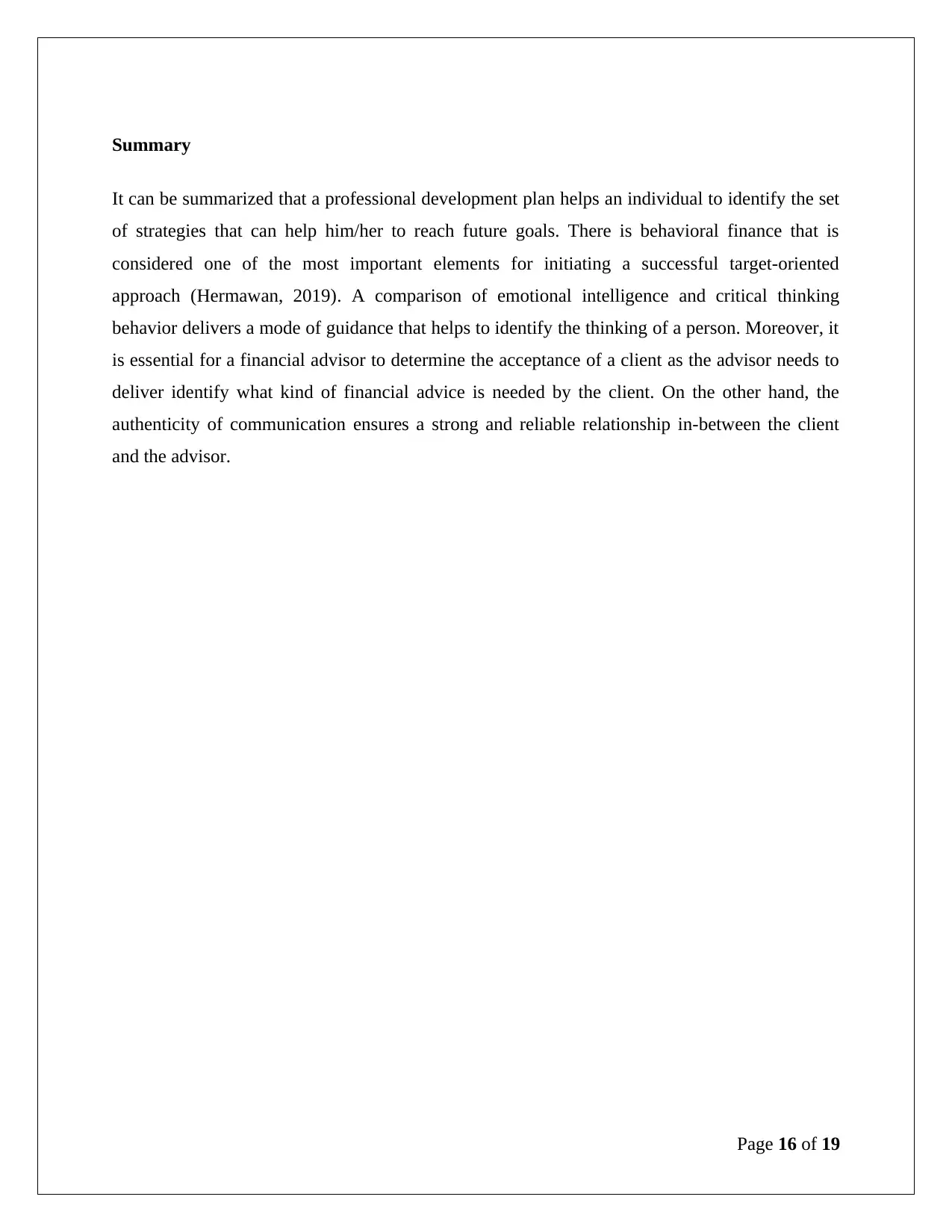
Summary
It can be summarized that a professional development plan helps an individual to identify the set
of strategies that can help him/her to reach future goals. There is behavioral finance that is
considered one of the most important elements for initiating a successful target-oriented
approach (Hermawan, 2019). A comparison of emotional intelligence and critical thinking
behavior delivers a mode of guidance that helps to identify the thinking of a person. Moreover, it
is essential for a financial advisor to determine the acceptance of a client as the advisor needs to
deliver identify what kind of financial advice is needed by the client. On the other hand, the
authenticity of communication ensures a strong and reliable relationship in-between the client
and the advisor.
Page 16 of 19
It can be summarized that a professional development plan helps an individual to identify the set
of strategies that can help him/her to reach future goals. There is behavioral finance that is
considered one of the most important elements for initiating a successful target-oriented
approach (Hermawan, 2019). A comparison of emotional intelligence and critical thinking
behavior delivers a mode of guidance that helps to identify the thinking of a person. Moreover, it
is essential for a financial advisor to determine the acceptance of a client as the advisor needs to
deliver identify what kind of financial advice is needed by the client. On the other hand, the
authenticity of communication ensures a strong and reliable relationship in-between the client
and the advisor.
Page 16 of 19
Secure Best Marks with AI Grader
Need help grading? Try our AI Grader for instant feedback on your assignments.
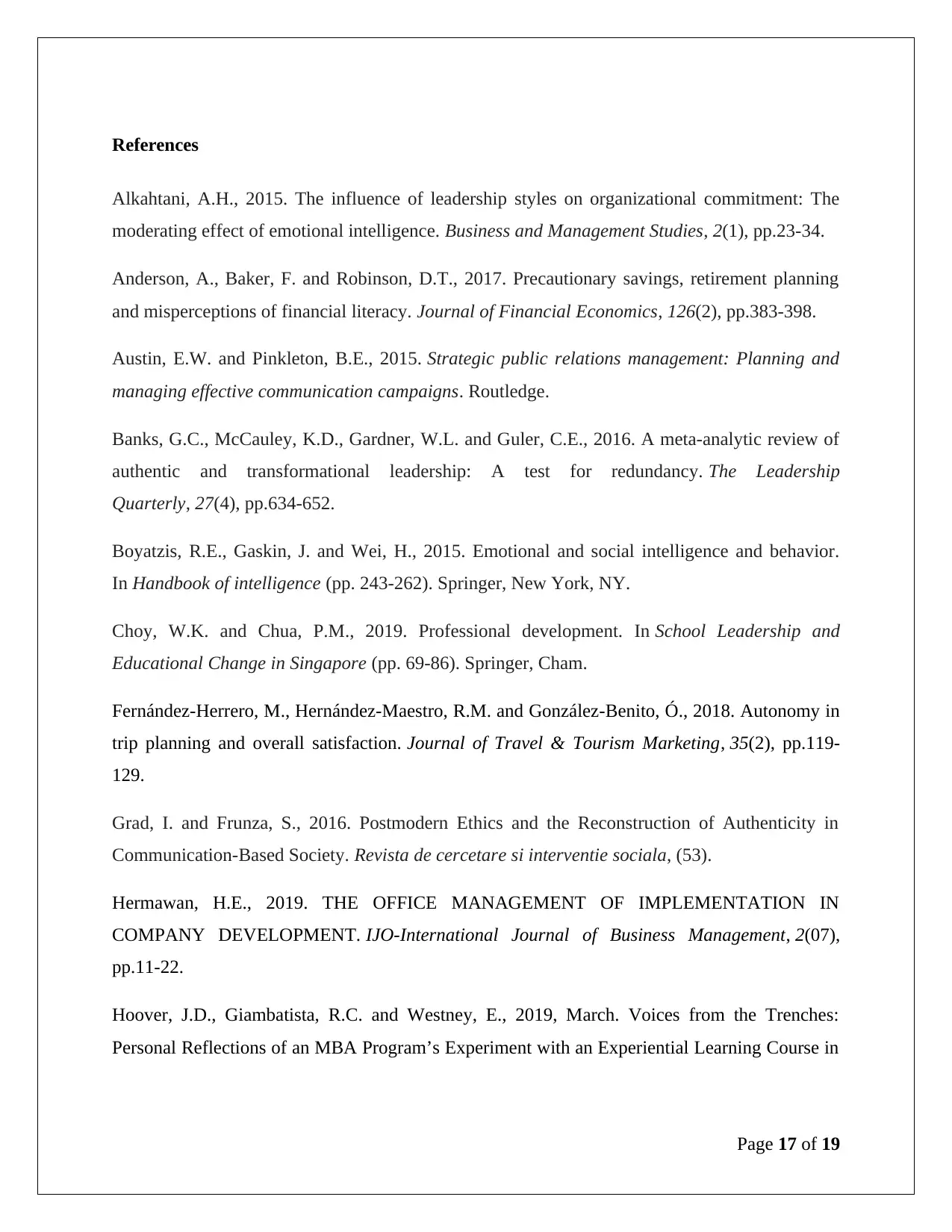
References
Alkahtani, A.H., 2015. The influence of leadership styles on organizational commitment: The
moderating effect of emotional intelligence. Business and Management Studies, 2(1), pp.23-34.
Anderson, A., Baker, F. and Robinson, D.T., 2017. Precautionary savings, retirement planning
and misperceptions of financial literacy. Journal of Financial Economics, 126(2), pp.383-398.
Austin, E.W. and Pinkleton, B.E., 2015. Strategic public relations management: Planning and
managing effective communication campaigns. Routledge.
Banks, G.C., McCauley, K.D., Gardner, W.L. and Guler, C.E., 2016. A meta-analytic review of
authentic and transformational leadership: A test for redundancy. The Leadership
Quarterly, 27(4), pp.634-652.
Boyatzis, R.E., Gaskin, J. and Wei, H., 2015. Emotional and social intelligence and behavior.
In Handbook of intelligence (pp. 243-262). Springer, New York, NY.
Choy, W.K. and Chua, P.M., 2019. Professional development. In School Leadership and
Educational Change in Singapore (pp. 69-86). Springer, Cham.
Fernández-Herrero, M., Hernández-Maestro, R.M. and González-Benito, Ó., 2018. Autonomy in
trip planning and overall satisfaction. Journal of Travel & Tourism Marketing, 35(2), pp.119-
129.
Grad, I. and Frunza, S., 2016. Postmodern Ethics and the Reconstruction of Authenticity in
Communication-Based Society. Revista de cercetare si interventie sociala, (53).
Hermawan, H.E., 2019. THE OFFICE MANAGEMENT OF IMPLEMENTATION IN
COMPANY DEVELOPMENT. IJO-International Journal of Business Management, 2(07),
pp.11-22.
Hoover, J.D., Giambatista, R.C. and Westney, E., 2019, March. Voices from the Trenches:
Personal Reflections of an MBA Program’s Experiment with an Experiential Learning Course in
Page 17 of 19
Alkahtani, A.H., 2015. The influence of leadership styles on organizational commitment: The
moderating effect of emotional intelligence. Business and Management Studies, 2(1), pp.23-34.
Anderson, A., Baker, F. and Robinson, D.T., 2017. Precautionary savings, retirement planning
and misperceptions of financial literacy. Journal of Financial Economics, 126(2), pp.383-398.
Austin, E.W. and Pinkleton, B.E., 2015. Strategic public relations management: Planning and
managing effective communication campaigns. Routledge.
Banks, G.C., McCauley, K.D., Gardner, W.L. and Guler, C.E., 2016. A meta-analytic review of
authentic and transformational leadership: A test for redundancy. The Leadership
Quarterly, 27(4), pp.634-652.
Boyatzis, R.E., Gaskin, J. and Wei, H., 2015. Emotional and social intelligence and behavior.
In Handbook of intelligence (pp. 243-262). Springer, New York, NY.
Choy, W.K. and Chua, P.M., 2019. Professional development. In School Leadership and
Educational Change in Singapore (pp. 69-86). Springer, Cham.
Fernández-Herrero, M., Hernández-Maestro, R.M. and González-Benito, Ó., 2018. Autonomy in
trip planning and overall satisfaction. Journal of Travel & Tourism Marketing, 35(2), pp.119-
129.
Grad, I. and Frunza, S., 2016. Postmodern Ethics and the Reconstruction of Authenticity in
Communication-Based Society. Revista de cercetare si interventie sociala, (53).
Hermawan, H.E., 2019. THE OFFICE MANAGEMENT OF IMPLEMENTATION IN
COMPANY DEVELOPMENT. IJO-International Journal of Business Management, 2(07),
pp.11-22.
Hoover, J.D., Giambatista, R.C. and Westney, E., 2019, March. Voices from the Trenches:
Personal Reflections of an MBA Program’s Experiment with an Experiential Learning Course in
Page 17 of 19

Executive Skills. In Developments in Business Simulation and Experiential Learning:
Proceedings of the Annual ABSEL conference (Vol. 46).
Hosseini, N., Pourkiyani, M. and Sheikhi, A., 2019. Analysis on Relationship Among
Competency and Succession Planning in Telecommunication Infrastructure Company of Iran
(TICIR). Journal of System Management, (2), pp.147-166.
Kan, J.Q. and Zhang, H.F., 2017. Effects of awareness diffusion and self-initiated awareness
behavior on epidemic spreading-an approach based on multiplex networks. Communications in
Nonlinear Science and Numerical Simulation, 44, pp.193-203.
Lewis, T.J., Barrett, S., Sugai, G., Horner, R.H., Mitchell, B.S. and Starkey, D., 2016. Training
and professional development blueprint for positive behavioral interventions and
supports. National Technical Assistance Center on Positive Behavior Interventions and Support.
Medora, N. and Roy, R.N., 2017. Recruiting, organizing, planning, and conducting a 3-week,
short-term study abroad program for undergraduate students: Guidelines and suggestions for
first-time faculty leaders. International Journal of Humanities and Social Science Research, 3,
pp.1-11.
Men, L.R., 2015. The internal communication role of the chief executive officer:
Communication channels, style, and effectiveness. Public Relations Review, 41(4), pp.461-471.
Rubens, A., Schoenfeld, G.A., Schaffer, B.S. and Leah, J.S., 2018. Self-awareness and
leadership: Developing an individual strategic professional development plan in an MBA
leadership course. The International Journal of Management Education, 16(1), pp.1-13.
Turner, P., 2018. Succession Planning and Leadership Development. In Talent Management in
Healthcare (pp. 157-187). Palgrave Macmillan, Cham.
West, T., Hunt, K., Johnson, D. and Webb, A., 2017. Career outcomes of financial planning
students (No. finance: 201702). Griffith University, Department of Accounting, Finance and
Economics.
Wheeler, R., 2016. Soft skills-the importance of cultivating emotional intelligence. AALL
Spectrum, 20(3), p.28.
Page 18 of 19
Proceedings of the Annual ABSEL conference (Vol. 46).
Hosseini, N., Pourkiyani, M. and Sheikhi, A., 2019. Analysis on Relationship Among
Competency and Succession Planning in Telecommunication Infrastructure Company of Iran
(TICIR). Journal of System Management, (2), pp.147-166.
Kan, J.Q. and Zhang, H.F., 2017. Effects of awareness diffusion and self-initiated awareness
behavior on epidemic spreading-an approach based on multiplex networks. Communications in
Nonlinear Science and Numerical Simulation, 44, pp.193-203.
Lewis, T.J., Barrett, S., Sugai, G., Horner, R.H., Mitchell, B.S. and Starkey, D., 2016. Training
and professional development blueprint for positive behavioral interventions and
supports. National Technical Assistance Center on Positive Behavior Interventions and Support.
Medora, N. and Roy, R.N., 2017. Recruiting, organizing, planning, and conducting a 3-week,
short-term study abroad program for undergraduate students: Guidelines and suggestions for
first-time faculty leaders. International Journal of Humanities and Social Science Research, 3,
pp.1-11.
Men, L.R., 2015. The internal communication role of the chief executive officer:
Communication channels, style, and effectiveness. Public Relations Review, 41(4), pp.461-471.
Rubens, A., Schoenfeld, G.A., Schaffer, B.S. and Leah, J.S., 2018. Self-awareness and
leadership: Developing an individual strategic professional development plan in an MBA
leadership course. The International Journal of Management Education, 16(1), pp.1-13.
Turner, P., 2018. Succession Planning and Leadership Development. In Talent Management in
Healthcare (pp. 157-187). Palgrave Macmillan, Cham.
West, T., Hunt, K., Johnson, D. and Webb, A., 2017. Career outcomes of financial planning
students (No. finance: 201702). Griffith University, Department of Accounting, Finance and
Economics.
Wheeler, R., 2016. Soft skills-the importance of cultivating emotional intelligence. AALL
Spectrum, 20(3), p.28.
Page 18 of 19
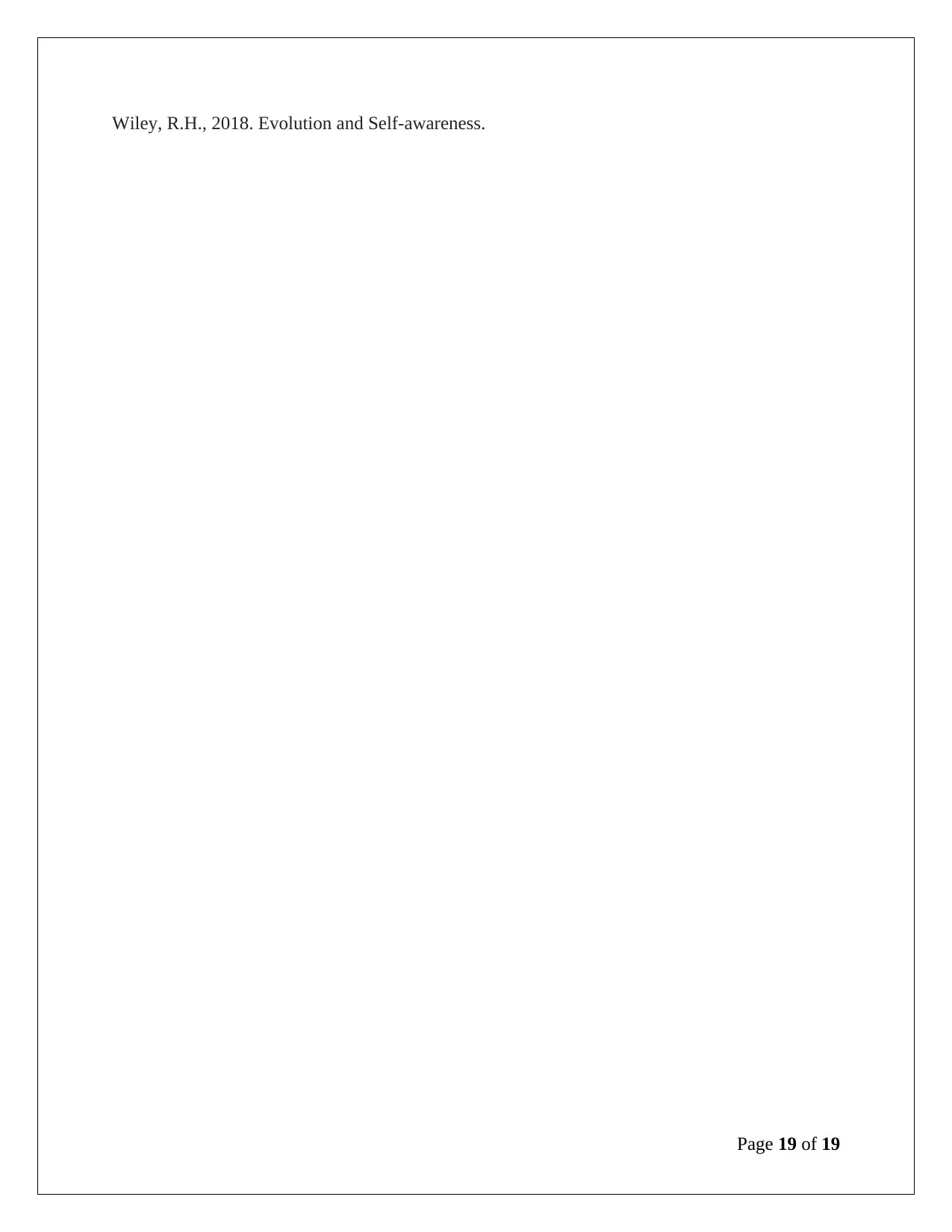
Wiley, R.H., 2018. Evolution and Self-awareness.
Page 19 of 19
Page 19 of 19
1 out of 19
Related Documents
Your All-in-One AI-Powered Toolkit for Academic Success.
+13062052269
info@desklib.com
Available 24*7 on WhatsApp / Email
![[object Object]](/_next/static/media/star-bottom.7253800d.svg)
Unlock your academic potential
© 2024 | Zucol Services PVT LTD | All rights reserved.





